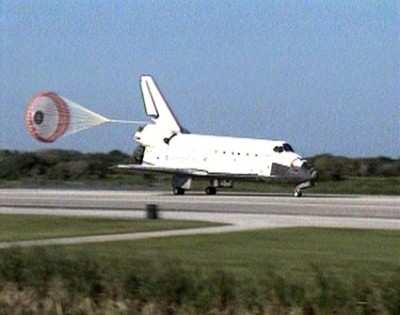Last Shuttle To Fly In Space Will Arrive Nov. 2 At The Site Of Its Future $100 Million Exhibit
And then, there was one. The last time a space shuttle will ever move will be November 2nd, when Atlantis, the last orbiter to fly in space, will also be the last orbiter to be transported to its final resting place at a museum. And the last orbiter to move has the least distance to cover.

Atlantis will travel the nearly 10 miles from Kennedy Space Center to its new home at Kennedy Space Center Visitor Complex. The move will begin at 0700 local time, when Atlantis leaves Kennedy Space Center's Vehicle Assembly Building (VAB) at about 2 miles per hour on the 106-foot-long Orbiter Transporter System. The orbiter will make its way to Kennedy Space Center headquarters, where at about 0945 thousands of current NASA employees and former shuttle workers are scheduled to attend a private event that will include a ceremony to mark the transfer of Atlantis to the visitor complex.
Atlantis will then head to Space Florida's Exploration Park, a 65-acre area that will provide a festival setting for a half-day event where guests can see the shuttle up close and "in the round." NASA Administrator Charles Bolden, Kennedy Space Center Director Robert Cabana and the space shuttle astronauts from STS-135, the final shuttle and Atlantis mission, are also expected to attend.
Because of crowd logistics and security – 70 percent of the route is in the restricted area of the space center – the only viewing opportunities for the move are being offered by the visitor complex via two different ticket packages requiring advance reservations. In addition, Exploration Park will feature spaceflight and exploration exhibits provided by several space industry partners and NASA, including the Orion Crew Module, designed for deep space human exploration as the flagship of the nation's next-generation space fleet. The Exploration Park portion of the day is open to those purchasing the special Explorer Package, which includes regular Kennedy Space Center Visitor Complex admission.

"The final trip of Atlantis will be the very last time anyone is going to see a space shuttle in motion or out in the open, making it a truly unique and momentous viewing opportunity," said Bill Moore, chief operating officer of Kennedy Space Center Visitor Complex for Delaware North Companies Parks & Resorts, which operates the visitor complex for NASA. "Atlantis is a spacecraft that has flown 33 missions into space, logging more than 125 million miles, and it was the last orbiter in space and the last to touch down at Kennedy Space Center. Seeing the orbiter up close will be an emotional experience," Moore said.
Atlantis will then leave Exploration Park and complete the final leg of its journey, traveling in front of Kennedy Space Center Visitor Complex along State Road 405/NASA Parkway before entering its new home, a $100 million interactive exhibit complex currently under construction and set to open in July 2013.
After the approximate 1800 arrival, a 10-minute fireworks show will illuminate the skies of Kennedy Space Center Visitor Complex, providing the grand finale to an extraordinary day. Explorer Package and regular visitor complex admission holders, through the Rollover Package, can witness the last part of Atlantis's journey as it enters the visitor complex.
NASA and Delaware North have spent the past year and a half planning the challenging logistics of Atlantis's 10-mile trek with a team of workers set to remove and replace 120 light poles, 23 traffic signals, 56 traffic signs and one high-voltage power line to make way for the orbiter.
(Images of Atlantis provided by NASA)
 Unfortunate... ANN/SportPlane Resource Guide Adds To Cautionary Advisories
Unfortunate... ANN/SportPlane Resource Guide Adds To Cautionary Advisories ANN FAQ: Turn On Post Notifications
ANN FAQ: Turn On Post Notifications ANN's Daily Aero-Term (04.29.24): Visual Approach Slope Indicator (VASI)
ANN's Daily Aero-Term (04.29.24): Visual Approach Slope Indicator (VASI) ANN's Daily Aero-Term (04.28.24): Airport Marking Aids
ANN's Daily Aero-Term (04.28.24): Airport Marking Aids ANN's Daily Aero-Linx (04.28.24)
ANN's Daily Aero-Linx (04.28.24)




